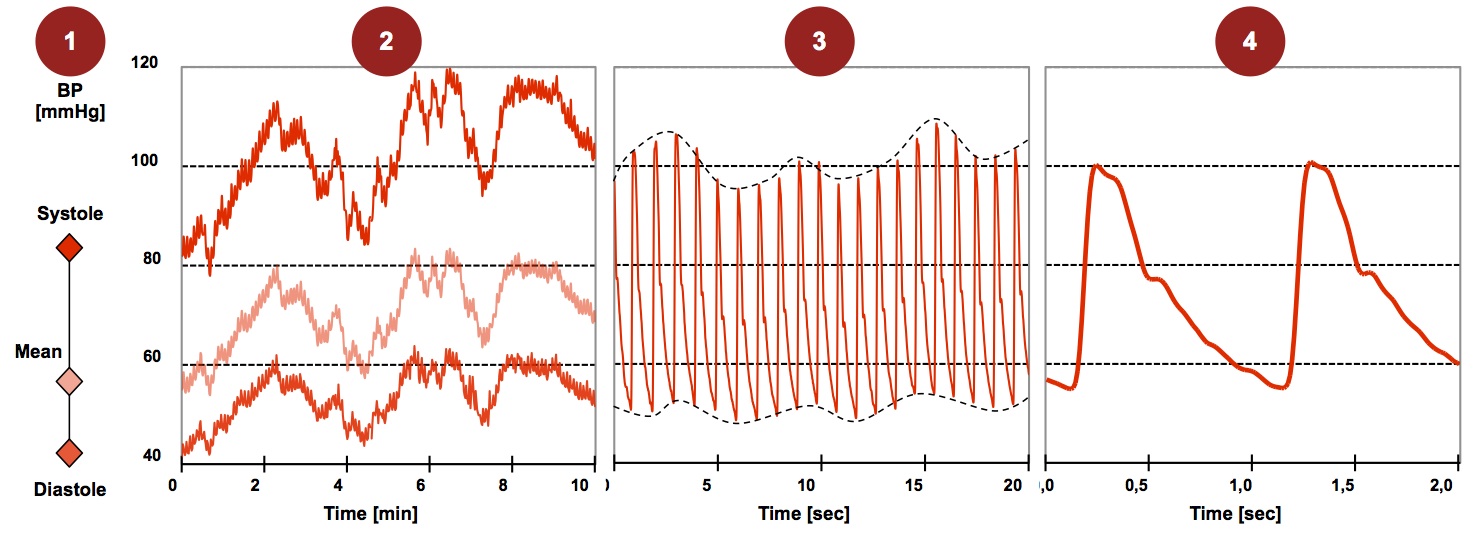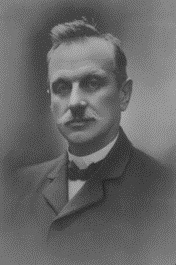|
Blood Pressure Measurement
Arterial blood pressure is most commonly measured via a sphygmomanometer, which historically used the height of a column of mercury to reflect the circulating pressure. Blood pressure values are generally reported in millimetres of mercury (mmHg), though aneroid and electronic devices do not contain mercury. For each heartbeat, blood pressure varies between systolic and diastolic pressures. Systolic pressure is peak pressure in the arteries, which occurs near the end of the cardiac cycle when the ventricles are contracting. Diastolic pressure is minimum pressure in the arteries, which occurs near the beginning of the cardiac cycle when the ventricles are filled with blood. An example of normal measured values for a resting, healthy adult human is 120 mmHg systolic and 80 mmHg diastolic (written as 120/80 mmHg, and spoken as "one-twenty over eighty"). Systolic and diastolic arterial blood pressures are not static but undergo natural variations from one heartbe ... [...More Info...] [...Related Items...] OR: [Wikipedia] [Google] [Baidu] |
Continuous Noninvasive Arterial Pressure
Continuous noninvasive arterial pressure (CNAP) is the method of measuring beat-to-beat arterial blood pressure in real-time without any interruptions (continuously) and without cannulating the human body (noninvasive). Benefit of CNAP technology Continuous noninvasive arterial blood pressure measurement (CNAP) combines the advantages of the following two clinical “gold standards”: it measures blood pressure (BP) continuously in real-time like the invasive arterial catheter system (IBP) and it is non-invasive like the standard upper arm sphygmomanometer (NBP). Latest developments in this field show promising results in terms of accuracy, ease of use and clinical acceptance. Clinical requirements For the use in clinical environment a CNAP system must provide the following blood pressure information: # Absolute blood pressure obtained from a proximal artery (e.g. arteria brachialis) # Blood pressure changes in order to detect hemodynamic instabilities # Physiological rhythm ... [...More Info...] [...Related Items...] OR: [Wikipedia] [Google] [Baidu] |
Body Temperature
Thermoregulation is the ability of an organism to keep its body temperature within certain boundaries, even when the surrounding temperature is very different. A thermoconforming organism, by contrast, simply adopts the surrounding temperature as its own body temperature, thus avoiding the need for internal thermoregulation. The internal thermoregulation process is one aspect of homeostasis: a state of dynamic stability in an organism's internal conditions, maintained far from thermal equilibrium with its environment (the study of such processes in zoology has been called physiological ecology). If the body is unable to maintain a normal temperature and it increases significantly above normal, a condition known as hyperthermia occurs. Humans may also experience lethal hyperthermia when the wet bulb temperature is sustained above for six hours. The opposite condition, when body temperature decreases below normal levels, is known as hypothermia. It results when the homeostatic c ... [...More Info...] [...Related Items...] OR: [Wikipedia] [Google] [Baidu] |
Cuff
A cuff is a layer of fabric at the lower edge of the sleeve of a garment (shirt, coat, jacket, etc.) at the wrist, or at the ankle end of a trouser leg. The function of turned-back cuffs is to protect the cloth of the garment from fraying, and, when frayed, to allow the cuffs to be readily repaired or replaced, without changing the garment. Cuffs are made by turning back (folding) the material, or a separate band of material can be sewn on, or worn separately, attached either by buttons or studs. A cuff may display an ornamental border or have lace or some other trimming. In US usage, the word ''trouser cuffs'' refers to the folded, finished bottoms of the legs of a pair of trousers. In the UK, while this usage is now sometimes followed, the traditional term for the turned up trouser hem is 'turnup'. History Between the 15th and 18th centuries, rich men often wore sleeve cuffs ornamented with fine lace. Still today, Catholic clergy have the cuffs of their choir dress ornamen ... [...More Info...] [...Related Items...] OR: [Wikipedia] [Google] [Baidu] |
Scipione Riva-Rocci
Scipione Riva Rocci (7 August 1863 in Almese, Piedmont – 15 March 1937 in Rapallo, Liguria) was an Italian internist, Pathology, pathologist and pediatrician. He is best known for the invention of an easy-to-use cuff-based version of the mercury sphygmomanometer for the measurement of blood pressure. Biography Riva Rocci was born on 7 August in Almese in 1863. He graduated in medicine and surgery in 1888 from the University of Turin. From 1888 to 1898 he acted as assistant lecturer at the Propaedeutics, propaedeutic medical clinic in Turin under the guidance of Carlo Forlanini and assisted him in the application of "iatrogenic pneumothorax" for treatment of pulmonary tuberculosis. In 1894 he graduated in pathology and in 1907 in pediatrics. In 1898, he followed Forlanini to the University of Pavia where he continued to contribute to the development of Forlanini's method by showing that the technique did not have a major adverse effect on lung function. From 1900 until ... [...More Info...] [...Related Items...] OR: [Wikipedia] [Google] [Baidu] |
Stethoscope
The stethoscope is a medical device for auscultation, or listening to internal sounds of an animal or human body. It typically has a small disc-shaped resonator that is placed against the skin, and one or two tubes connected to two earpieces. A stethoscope can be used to listen to the sounds made by the heart, lungs or intestines, as well as blood flow in arteries and veins. In combination with a manual sphygmomanometer, it is commonly used when measuring blood pressure. Less commonly, "mechanic's stethoscopes", equipped with rod shaped chestpieces, are used to listen to internal sounds made by machines (for example, sounds and vibrations emitted by worn ball bearings), such as diagnosing a malfunctioning automobile engine by listening to the sounds of its internal parts. Stethoscopes can also be used to check scientific vacuum chambers for leaks and for various other small-scale acoustic monitoring tasks. A stethoscope that intensifies auscultatory sounds is called a phonen ... [...More Info...] [...Related Items...] OR: [Wikipedia] [Google] [Baidu] |
Sphygmomanometer
A sphygmomanometer ( ), a blood pressure monitor, or blood pressure gauge, is a device used to measure blood pressure, composed of an inflatable cuff to collapse and then release the artery under the cuff in a controlled manner, and a mercury (element), mercury or Pressure measurement#Aneroid, aneroid manometer to measure the pressure. Manual sphygmomanometers are used with a stethoscope when using the Auscultation, auscultatory technique. A sphygmomanometer consists of an inflatable cuff, a measuring unit (the Pressure measurement#Liquid column (manometer), mercury manometer, or aneroid gauge), and a mechanism for inflation which may be a manually operated bulb and valve or a pump operated electrically. Types Both manual and digital meters are currently employed, with different trade-offs in accuracy versus convenience. Manual A stethoscope is required for auscultation (#A stethoscope is required for auscultation (see below), see below). Manual meters are best used by trai ... [...More Info...] [...Related Items...] OR: [Wikipedia] [Google] [Baidu] |
University Of Florida
The University of Florida (Florida or UF) is a public land-grant research university in Gainesville, Florida. It is a senior member of the State University System of Florida, traces its origins to 1853, and has operated continuously on its Gainesville campus since September 1906. After the Florida state legislature's creation of performance standards in 2013, the Florida Board of Governors designated the University of Florida as a "preeminent university". For 2022, '' U.S. News & World Report'' ranked Florida as the fifth (tied) best public university and 28th (tied) best university in the United States. The University of Florida is the only member of the Association of American Universities in Florida and is classified among "R1: Doctoral Universities – Very high research activity". The university is accredited by the Southern Association of Colleges and Schools (SACS). It is the third largest Florida university by student population,Nathan Crabbe, UF is no longer la ... [...More Info...] [...Related Items...] OR: [Wikipedia] [Google] [Baidu] |
Percentile
In statistics, a ''k''-th percentile (percentile score or centile) is a score ''below which'' a given percentage ''k'' of scores in its frequency distribution falls (exclusive definition) or a score ''at or below which'' a given percentage falls (inclusive definition). For example, the 50th percentile (the median) is the score below which 50% of the scores in the distribution are found (by the "exclusive" definition), or at or below which 50% of the scores are found (by the "inclusive" definition). Percentiles are expressed in the same unit of measurement as the input scores; for example, if the scores refer to human weight, the corresponding percentiles will be expressed in kilograms or pounds. The percentile score and the '' percentile rank'' are related terms. The percentile rank of a score is the percentage of scores in its distribution that are less than it, an exclusive definition, and one that can be expressed with a single, simple formula. Percentile scores and perce ... [...More Info...] [...Related Items...] OR: [Wikipedia] [Google] [Baidu] |
Emergency Medical Service
Emergency medical services (EMS), also known as ambulance services or paramedic services, are emergency services that provide urgent pre-hospital treatment and stabilisation for serious illness and injuries and transport to definitive care. They may also be known as a first aid squad, FAST squad, emergency squad, ambulance squad, ambulance corps, life squad or by other initialisms such as EMAS or EMARS. In most places, the EMS can be summoned by members of the public (as well as medical facilities, other emergency services, businesses and authorities) via an emergency telephone number which puts them in contact with a control facility, which will then dispatch a suitable resource for the situation. Ambulances are the primary vehicles for delivering EMS, though some also use squad cars, motorcycles, aircraft, or boats. EMS agencies may also operate a non-emergency patient transport service, and some have rescue squads to provide technical rescue services. As a first resort ... [...More Info...] [...Related Items...] OR: [Wikipedia] [Google] [Baidu] |
Palpation
Palpation is the process of using one's hands to check the body, especially while perceiving/diagnosing a disease or illness. Usually performed by a health care practitioner, it is the process of feeling an object in or on the body to determine its size, shape, firmness, or location (for example, a veterinarian can feel the stomach of a pregnant animal to ensure good health and successful delivery). Palpation is an important part of the physical examination; the sense of touch is just as important in this examination as the sense of sight is. Physicians develop great skill in palpating problems below the surface of the body, becoming able to detect things that untrained persons would not. Mastery of anatomy and much practice are required to achieve a high level of skill. The concept of being able to detect or notice subtle tactile signs and to recognize their significance or implications is called appreciating them (just as in general vocabulary one can speak of appreciating ... [...More Info...] [...Related Items...] OR: [Wikipedia] [Google] [Baidu] |
Auscultation
Auscultation (based on the Latin verb ''auscultare'' "to listen") is listening to the internal sounds of the body, usually using a stethoscope. Auscultation is performed for the purposes of examining the circulatory and respiratory systems (heart and breath sounds), as well as the alimentary canal. The term was introduced by René Laennec. The act of listening to body sounds for diagnostic purposes has its origin further back in history, possibly as early as Ancient Egypt. (Auscultation and palpation go together in physical examination and are alike in that both have ancient roots, both require skill, and both are still important today.) Laënnec's contributions were refining the procedure, linking sounds with specific pathological changes in the chest, and inventing a suitable instrument (the stethoscope) to mediate between the patient's body and the clinician's ear. Auscultation is a skill that requires substantial clinical experience, a fine stethoscope and good listening s ... [...More Info...] [...Related Items...] OR: [Wikipedia] [Google] [Baidu] |






_p174_GAINESVILLE%2C_EAST_FLORIDA_SEMINARY.jpg)


